Business Economics Report: Analysis of UK Economy and Tesco's Strategy
VerifiedAdded on 2020/05/11
|22
|4930
|106
Report
AI Summary
This report provides a comprehensive analysis of the UK economy, focusing on its characteristics, economic systems, and impact on business organizations. It explores resource allocation, market structures, and the role of supply and demand in determining prices. The report examines Tesco's business strategies, including pricing policies, corporate objectives, and market power within the context of oligopolistic competition. It also discusses the changes in the UK economy, shifting from a manufacturing-based to a service-based economy. The report includes an analysis of price elasticity of demand and the influence of competition policy on Tesco's operations. The study covers various aspects of the UK economy and its implications for businesses, particularly focusing on Tesco's strategies and market dynamics, including the impact of competition and regulatory policies.
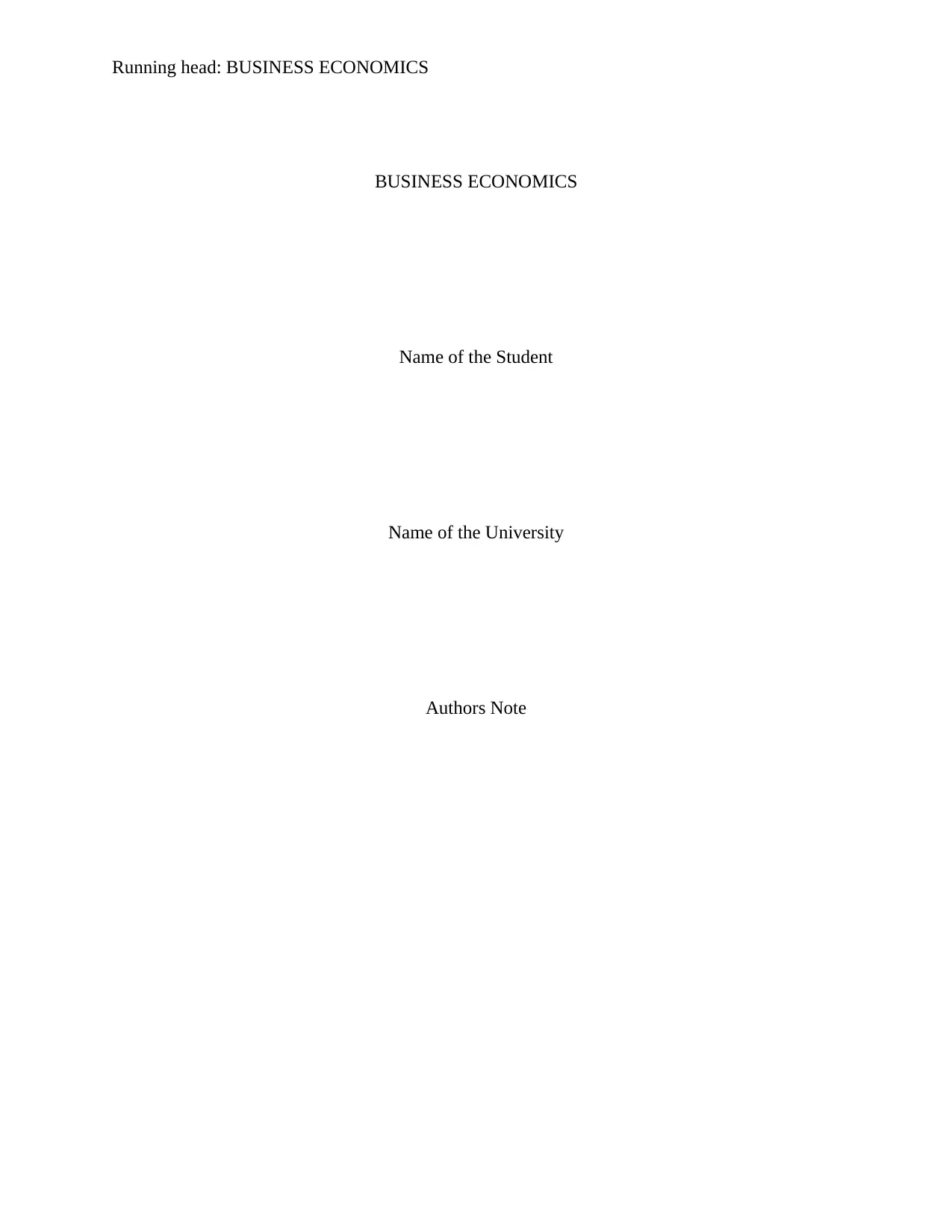
Running head: BUSINESS ECONOMICS
BUSINESS ECONOMICS
Name of the Student
Name of the University
Authors Note
BUSINESS ECONOMICS
Name of the Student
Name of the University
Authors Note
Paraphrase This Document
Need a fresh take? Get an instant paraphrase of this document with our AI Paraphraser
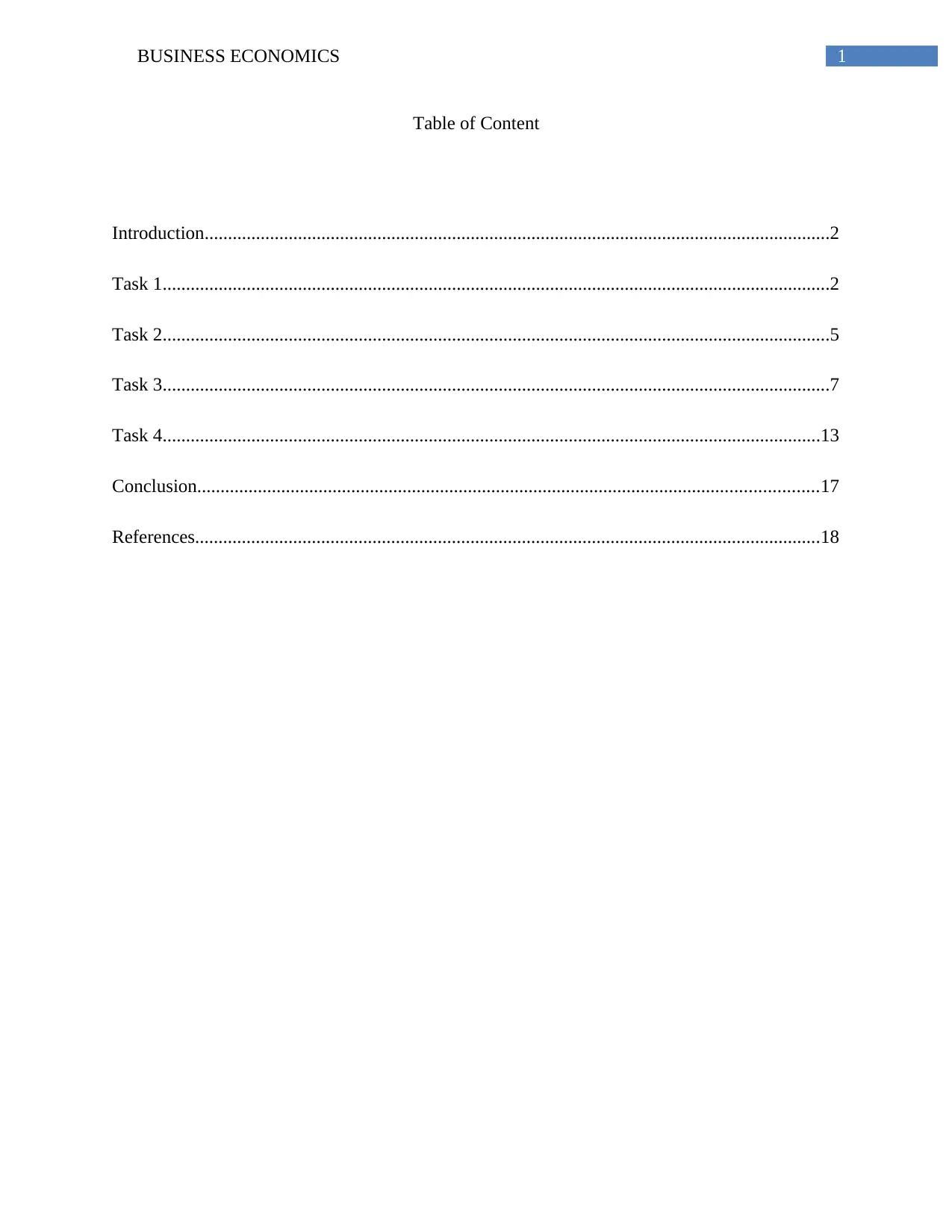
1BUSINESS ECONOMICS
Table of Content
Introduction......................................................................................................................................2
Task 1...............................................................................................................................................2
Task 2...............................................................................................................................................5
Task 3...............................................................................................................................................7
Task 4.............................................................................................................................................13
Conclusion.....................................................................................................................................17
References......................................................................................................................................18
Table of Content
Introduction......................................................................................................................................2
Task 1...............................................................................................................................................2
Task 2...............................................................................................................................................5
Task 3...............................................................................................................................................7
Task 4.............................................................................................................................................13
Conclusion.....................................................................................................................................17
References......................................................................................................................................18
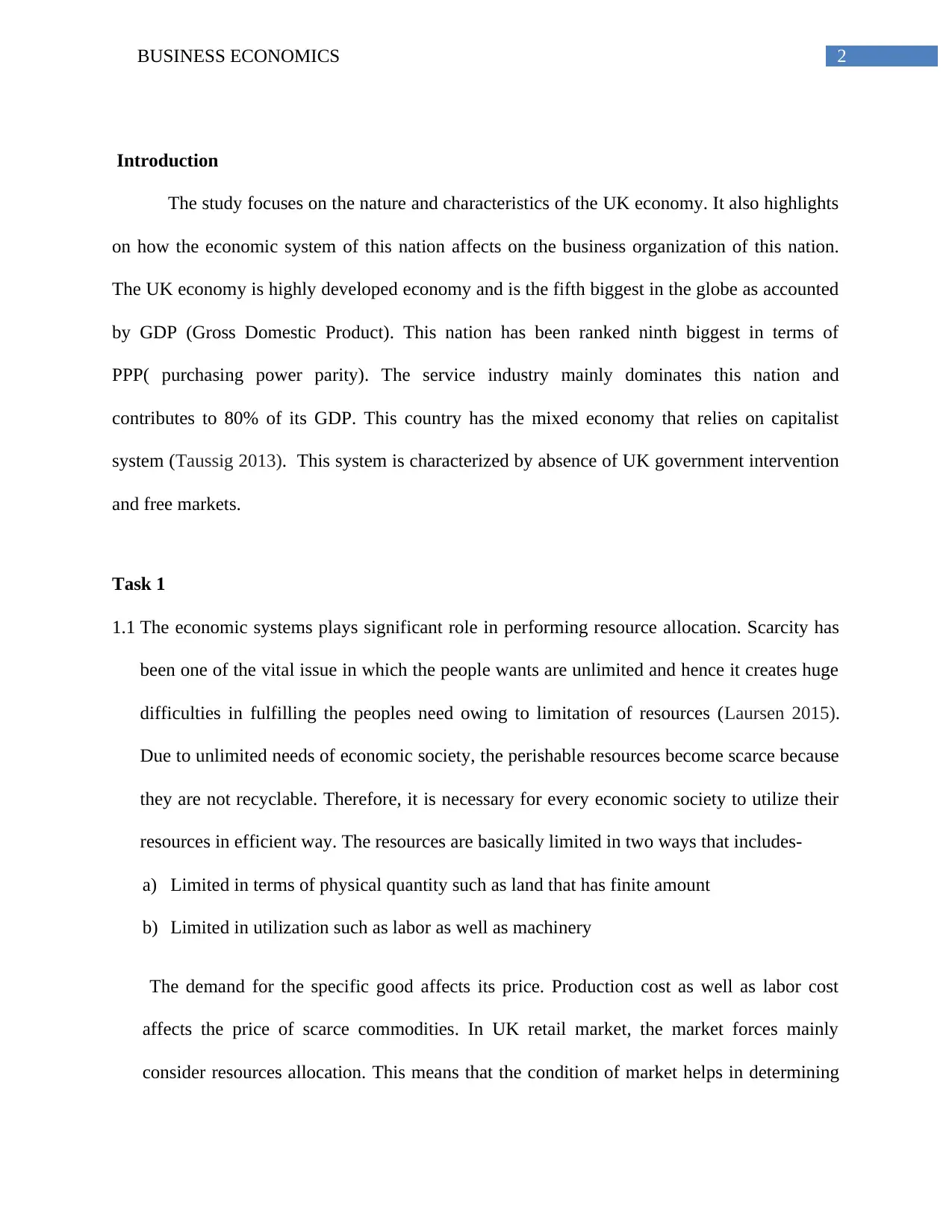
2BUSINESS ECONOMICS
Introduction
The study focuses on the nature and characteristics of the UK economy. It also highlights
on how the economic system of this nation affects on the business organization of this nation.
The UK economy is highly developed economy and is the fifth biggest in the globe as accounted
by GDP (Gross Domestic Product). This nation has been ranked ninth biggest in terms of
PPP( purchasing power parity). The service industry mainly dominates this nation and
contributes to 80% of its GDP. This country has the mixed economy that relies on capitalist
system (Taussig 2013). This system is characterized by absence of UK government intervention
and free markets.
Task 1
1.1 The economic systems plays significant role in performing resource allocation. Scarcity has
been one of the vital issue in which the people wants are unlimited and hence it creates huge
difficulties in fulfilling the peoples need owing to limitation of resources (Laursen 2015).
Due to unlimited needs of economic society, the perishable resources become scarce because
they are not recyclable. Therefore, it is necessary for every economic society to utilize their
resources in efficient way. The resources are basically limited in two ways that includes-
a) Limited in terms of physical quantity such as land that has finite amount
b) Limited in utilization such as labor as well as machinery
The demand for the specific good affects its price. Production cost as well as labor cost
affects the price of scarce commodities. In UK retail market, the market forces mainly
consider resources allocation. This means that the condition of market helps in determining
Introduction
The study focuses on the nature and characteristics of the UK economy. It also highlights
on how the economic system of this nation affects on the business organization of this nation.
The UK economy is highly developed economy and is the fifth biggest in the globe as accounted
by GDP (Gross Domestic Product). This nation has been ranked ninth biggest in terms of
PPP( purchasing power parity). The service industry mainly dominates this nation and
contributes to 80% of its GDP. This country has the mixed economy that relies on capitalist
system (Taussig 2013). This system is characterized by absence of UK government intervention
and free markets.
Task 1
1.1 The economic systems plays significant role in performing resource allocation. Scarcity has
been one of the vital issue in which the people wants are unlimited and hence it creates huge
difficulties in fulfilling the peoples need owing to limitation of resources (Laursen 2015).
Due to unlimited needs of economic society, the perishable resources become scarce because
they are not recyclable. Therefore, it is necessary for every economic society to utilize their
resources in efficient way. The resources are basically limited in two ways that includes-
a) Limited in terms of physical quantity such as land that has finite amount
b) Limited in utilization such as labor as well as machinery
The demand for the specific good affects its price. Production cost as well as labor cost
affects the price of scarce commodities. In UK retail market, the market forces mainly
consider resources allocation. This means that the condition of market helps in determining
⊘ This is a preview!⊘
Do you want full access?
Subscribe today to unlock all pages.

Trusted by 1+ million students worldwide
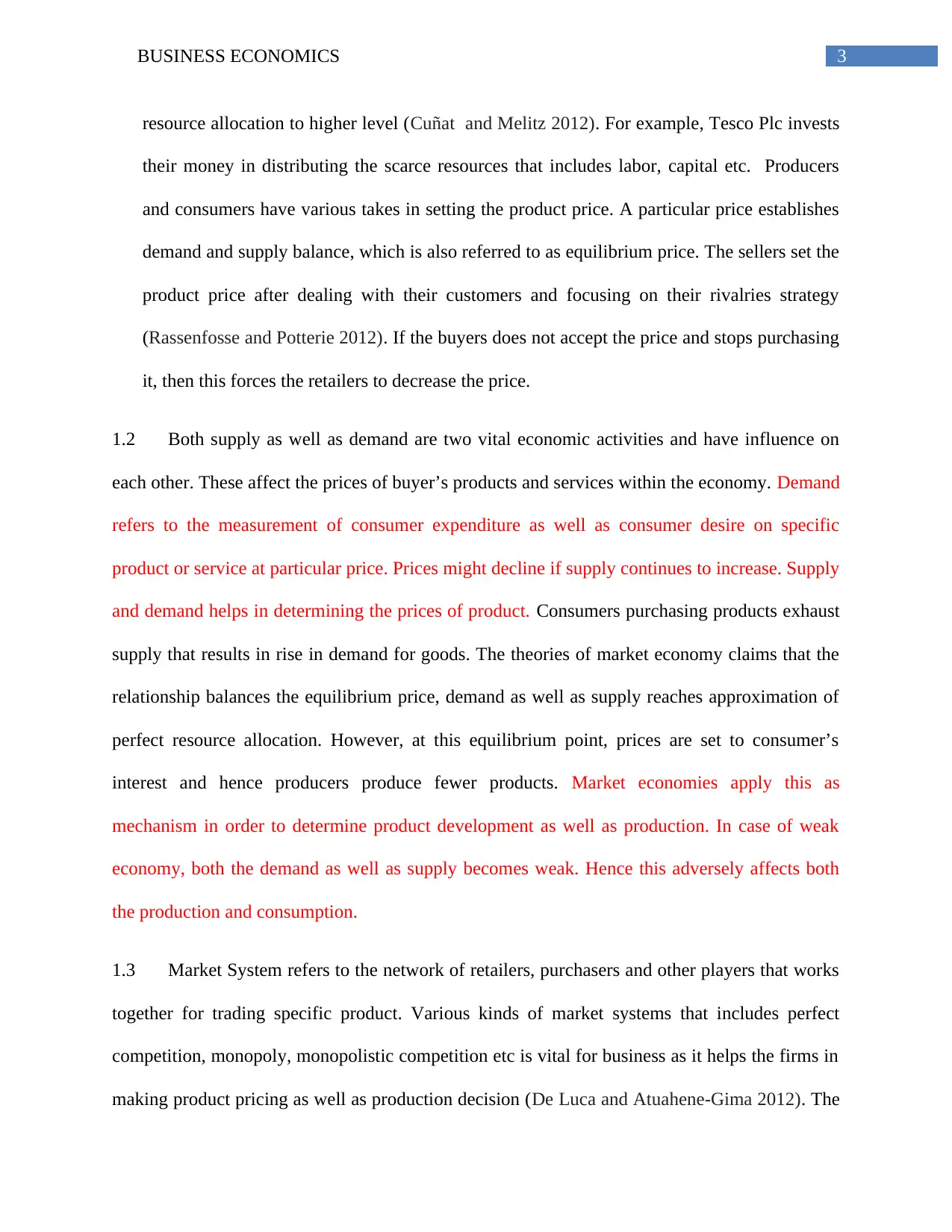
3BUSINESS ECONOMICS
resource allocation to higher level (Cuñat and Melitz 2012). For example, Tesco Plc invests
their money in distributing the scarce resources that includes labor, capital etc. Producers
and consumers have various takes in setting the product price. A particular price establishes
demand and supply balance, which is also referred to as equilibrium price. The sellers set the
product price after dealing with their customers and focusing on their rivalries strategy
(Rassenfosse and Potterie 2012). If the buyers does not accept the price and stops purchasing
it, then this forces the retailers to decrease the price.
1.2 Both supply as well as demand are two vital economic activities and have influence on
each other. These affect the prices of buyer’s products and services within the economy. Demand
refers to the measurement of consumer expenditure as well as consumer desire on specific
product or service at particular price. Prices might decline if supply continues to increase. Supply
and demand helps in determining the prices of product. Consumers purchasing products exhaust
supply that results in rise in demand for goods. The theories of market economy claims that the
relationship balances the equilibrium price, demand as well as supply reaches approximation of
perfect resource allocation. However, at this equilibrium point, prices are set to consumer’s
interest and hence producers produce fewer products. Market economies apply this as
mechanism in order to determine product development as well as production. In case of weak
economy, both the demand as well as supply becomes weak. Hence this adversely affects both
the production and consumption.
1.3 Market System refers to the network of retailers, purchasers and other players that works
together for trading specific product. Various kinds of market systems that includes perfect
competition, monopoly, monopolistic competition etc is vital for business as it helps the firms in
making product pricing as well as production decision (De Luca and Atuahene-Gima 2012). The
resource allocation to higher level (Cuñat and Melitz 2012). For example, Tesco Plc invests
their money in distributing the scarce resources that includes labor, capital etc. Producers
and consumers have various takes in setting the product price. A particular price establishes
demand and supply balance, which is also referred to as equilibrium price. The sellers set the
product price after dealing with their customers and focusing on their rivalries strategy
(Rassenfosse and Potterie 2012). If the buyers does not accept the price and stops purchasing
it, then this forces the retailers to decrease the price.
1.2 Both supply as well as demand are two vital economic activities and have influence on
each other. These affect the prices of buyer’s products and services within the economy. Demand
refers to the measurement of consumer expenditure as well as consumer desire on specific
product or service at particular price. Prices might decline if supply continues to increase. Supply
and demand helps in determining the prices of product. Consumers purchasing products exhaust
supply that results in rise in demand for goods. The theories of market economy claims that the
relationship balances the equilibrium price, demand as well as supply reaches approximation of
perfect resource allocation. However, at this equilibrium point, prices are set to consumer’s
interest and hence producers produce fewer products. Market economies apply this as
mechanism in order to determine product development as well as production. In case of weak
economy, both the demand as well as supply becomes weak. Hence this adversely affects both
the production and consumption.
1.3 Market System refers to the network of retailers, purchasers and other players that works
together for trading specific product. Various kinds of market systems that includes perfect
competition, monopoly, monopolistic competition etc is vital for business as it helps the firms in
making product pricing as well as production decision (De Luca and Atuahene-Gima 2012). The
Paraphrase This Document
Need a fresh take? Get an instant paraphrase of this document with our AI Paraphraser
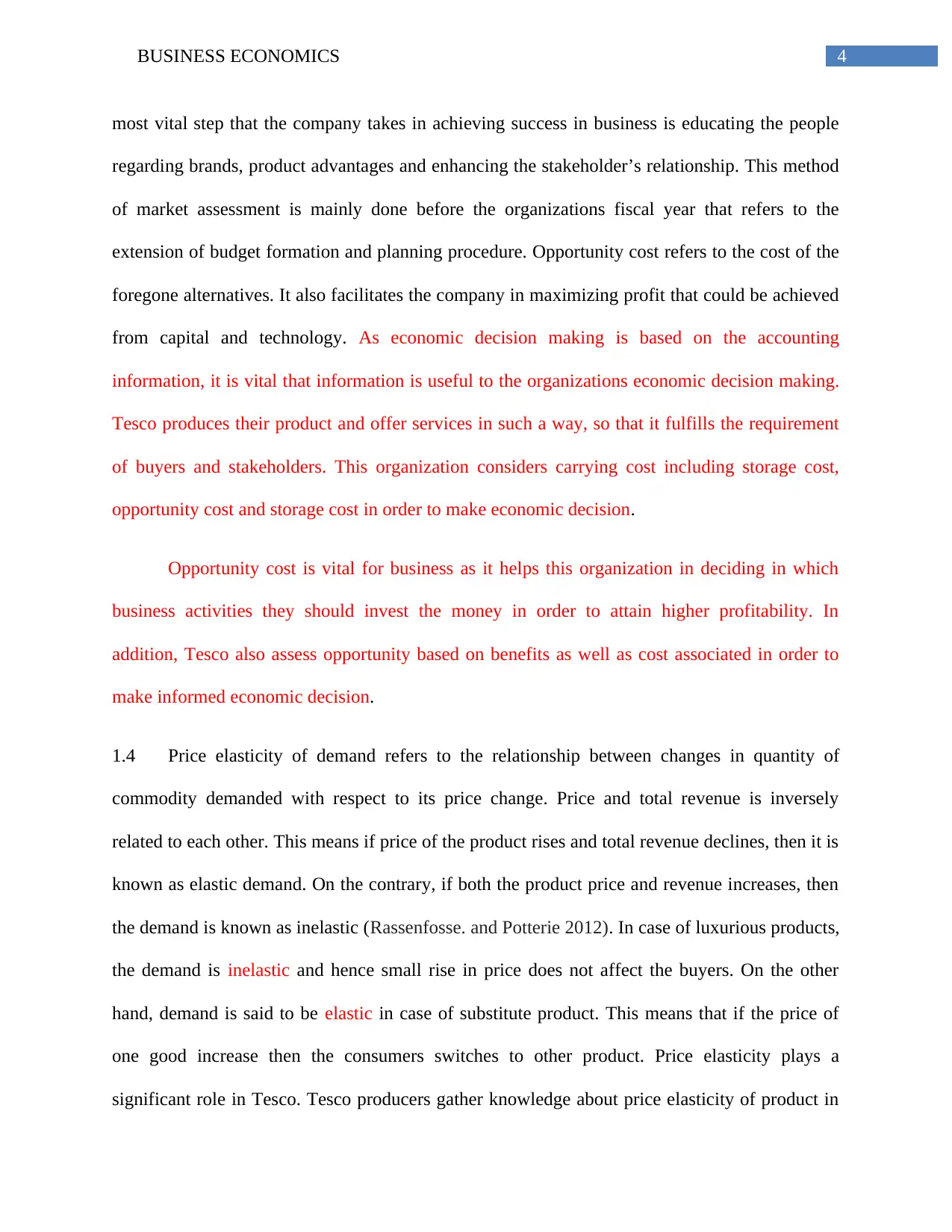
4BUSINESS ECONOMICS
most vital step that the company takes in achieving success in business is educating the people
regarding brands, product advantages and enhancing the stakeholder’s relationship. This method
of market assessment is mainly done before the organizations fiscal year that refers to the
extension of budget formation and planning procedure. Opportunity cost refers to the cost of the
foregone alternatives. It also facilitates the company in maximizing profit that could be achieved
from capital and technology. As economic decision making is based on the accounting
information, it is vital that information is useful to the organizations economic decision making.
Tesco produces their product and offer services in such a way, so that it fulfills the requirement
of buyers and stakeholders. This organization considers carrying cost including storage cost,
opportunity cost and storage cost in order to make economic decision.
Opportunity cost is vital for business as it helps this organization in deciding in which
business activities they should invest the money in order to attain higher profitability. In
addition, Tesco also assess opportunity based on benefits as well as cost associated in order to
make informed economic decision.
1.4 Price elasticity of demand refers to the relationship between changes in quantity of
commodity demanded with respect to its price change. Price and total revenue is inversely
related to each other. This means if price of the product rises and total revenue declines, then it is
known as elastic demand. On the contrary, if both the product price and revenue increases, then
the demand is known as inelastic (Rassenfosse. and Potterie 2012). In case of luxurious products,
the demand is inelastic and hence small rise in price does not affect the buyers. On the other
hand, demand is said to be elastic in case of substitute product. This means that if the price of
one good increase then the consumers switches to other product. Price elasticity plays a
significant role in Tesco. Tesco producers gather knowledge about price elasticity of product in
most vital step that the company takes in achieving success in business is educating the people
regarding brands, product advantages and enhancing the stakeholder’s relationship. This method
of market assessment is mainly done before the organizations fiscal year that refers to the
extension of budget formation and planning procedure. Opportunity cost refers to the cost of the
foregone alternatives. It also facilitates the company in maximizing profit that could be achieved
from capital and technology. As economic decision making is based on the accounting
information, it is vital that information is useful to the organizations economic decision making.
Tesco produces their product and offer services in such a way, so that it fulfills the requirement
of buyers and stakeholders. This organization considers carrying cost including storage cost,
opportunity cost and storage cost in order to make economic decision.
Opportunity cost is vital for business as it helps this organization in deciding in which
business activities they should invest the money in order to attain higher profitability. In
addition, Tesco also assess opportunity based on benefits as well as cost associated in order to
make informed economic decision.
1.4 Price elasticity of demand refers to the relationship between changes in quantity of
commodity demanded with respect to its price change. Price and total revenue is inversely
related to each other. This means if price of the product rises and total revenue declines, then it is
known as elastic demand. On the contrary, if both the product price and revenue increases, then
the demand is known as inelastic (Rassenfosse. and Potterie 2012). In case of luxurious products,
the demand is inelastic and hence small rise in price does not affect the buyers. On the other
hand, demand is said to be elastic in case of substitute product. This means that if the price of
one good increase then the consumers switches to other product. Price elasticity plays a
significant role in Tesco. Tesco producers gather knowledge about price elasticity of product in
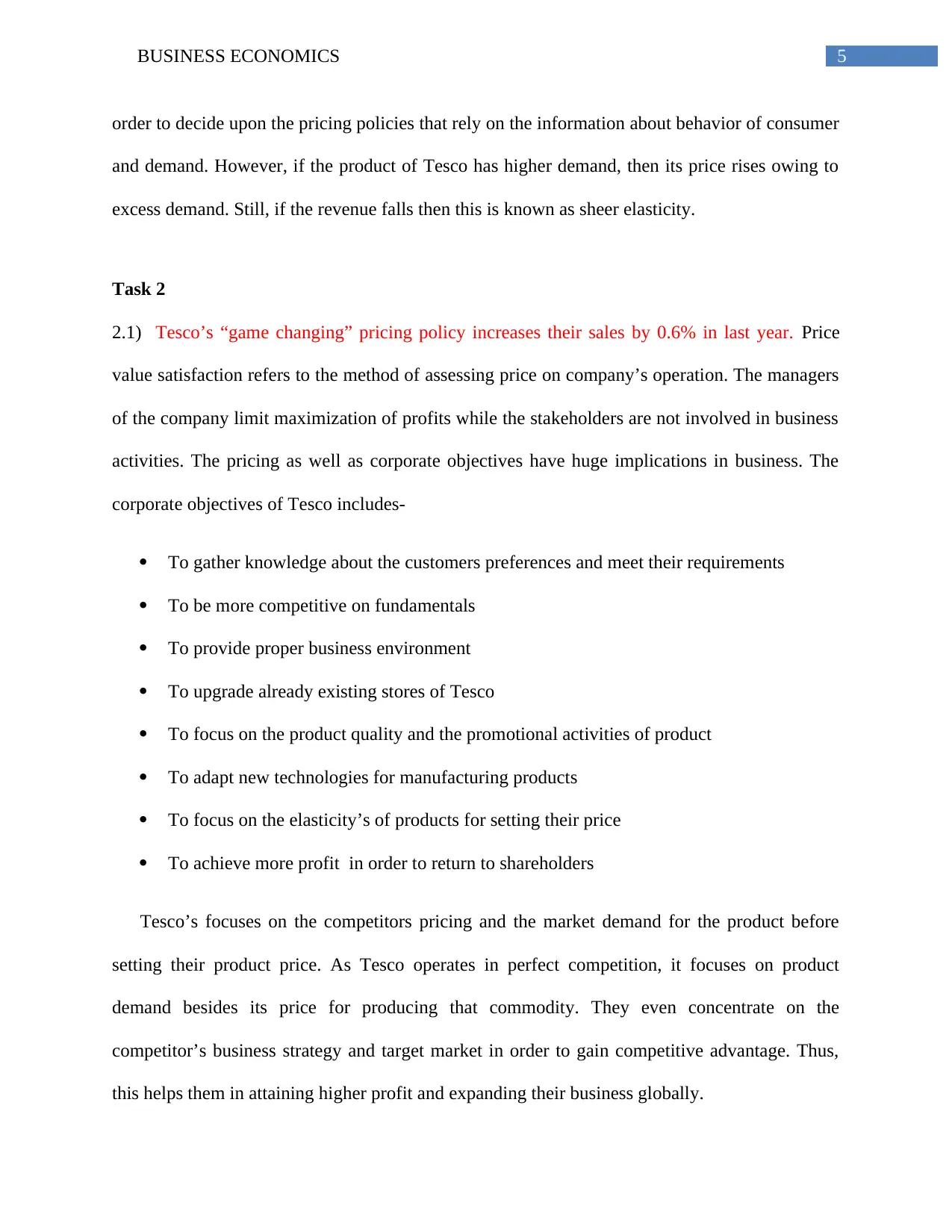
5BUSINESS ECONOMICS
order to decide upon the pricing policies that rely on the information about behavior of consumer
and demand. However, if the product of Tesco has higher demand, then its price rises owing to
excess demand. Still, if the revenue falls then this is known as sheer elasticity.
Task 2
2.1) Tesco’s “game changing” pricing policy increases their sales by 0.6% in last year. Price
value satisfaction refers to the method of assessing price on company’s operation. The managers
of the company limit maximization of profits while the stakeholders are not involved in business
activities. The pricing as well as corporate objectives have huge implications in business. The
corporate objectives of Tesco includes-
To gather knowledge about the customers preferences and meet their requirements
To be more competitive on fundamentals
To provide proper business environment
To upgrade already existing stores of Tesco
To focus on the product quality and the promotional activities of product
To adapt new technologies for manufacturing products
To focus on the elasticity’s of products for setting their price
To achieve more profit in order to return to shareholders
Tesco’s focuses on the competitors pricing and the market demand for the product before
setting their product price. As Tesco operates in perfect competition, it focuses on product
demand besides its price for producing that commodity. They even concentrate on the
competitor’s business strategy and target market in order to gain competitive advantage. Thus,
this helps them in attaining higher profit and expanding their business globally.
order to decide upon the pricing policies that rely on the information about behavior of consumer
and demand. However, if the product of Tesco has higher demand, then its price rises owing to
excess demand. Still, if the revenue falls then this is known as sheer elasticity.
Task 2
2.1) Tesco’s “game changing” pricing policy increases their sales by 0.6% in last year. Price
value satisfaction refers to the method of assessing price on company’s operation. The managers
of the company limit maximization of profits while the stakeholders are not involved in business
activities. The pricing as well as corporate objectives have huge implications in business. The
corporate objectives of Tesco includes-
To gather knowledge about the customers preferences and meet their requirements
To be more competitive on fundamentals
To provide proper business environment
To upgrade already existing stores of Tesco
To focus on the product quality and the promotional activities of product
To adapt new technologies for manufacturing products
To focus on the elasticity’s of products for setting their price
To achieve more profit in order to return to shareholders
Tesco’s focuses on the competitors pricing and the market demand for the product before
setting their product price. As Tesco operates in perfect competition, it focuses on product
demand besides its price for producing that commodity. They even concentrate on the
competitor’s business strategy and target market in order to gain competitive advantage. Thus,
this helps them in attaining higher profit and expanding their business globally.
⊘ This is a preview!⊘
Do you want full access?
Subscribe today to unlock all pages.

Trusted by 1+ million students worldwide
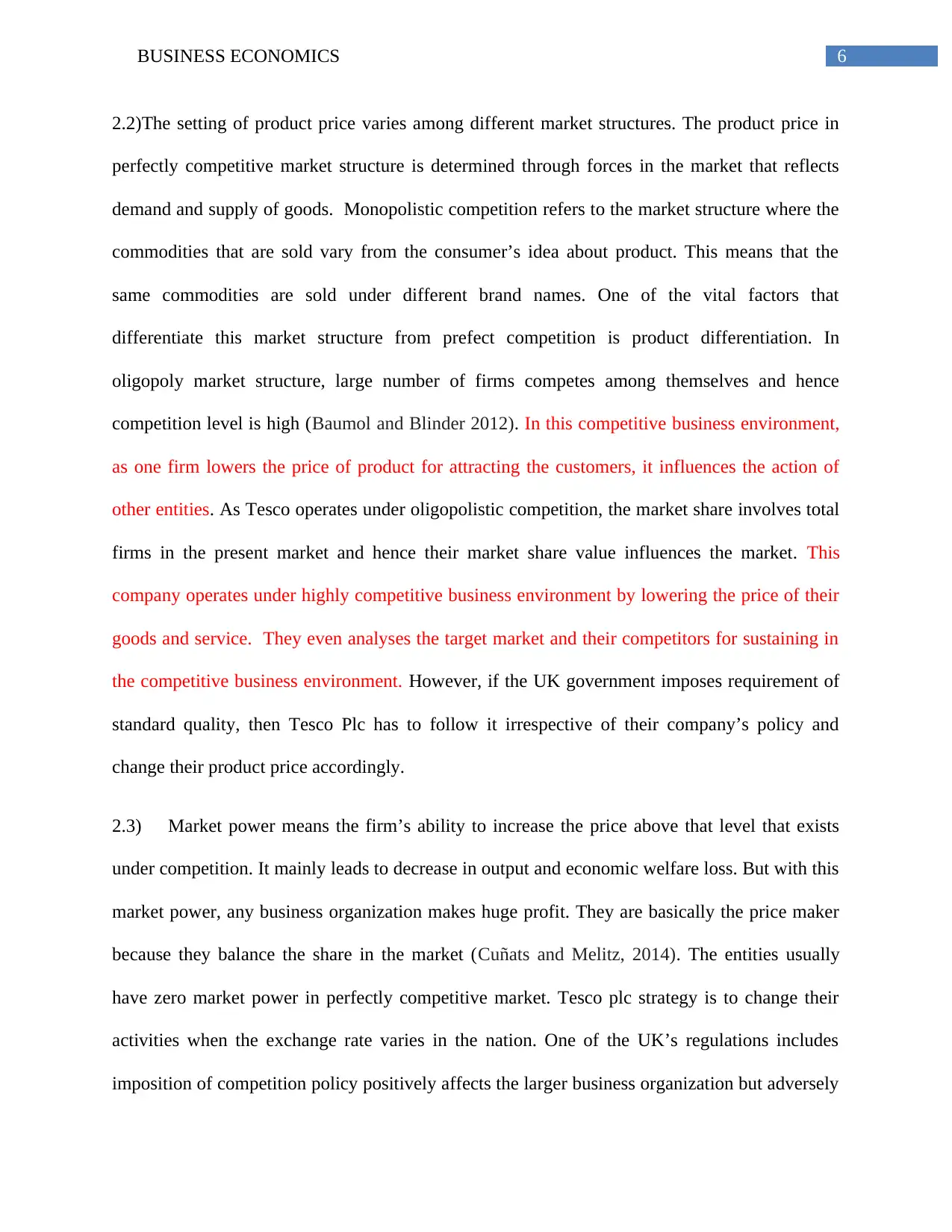
6BUSINESS ECONOMICS
2.2)The setting of product price varies among different market structures. The product price in
perfectly competitive market structure is determined through forces in the market that reflects
demand and supply of goods. Monopolistic competition refers to the market structure where the
commodities that are sold vary from the consumer’s idea about product. This means that the
same commodities are sold under different brand names. One of the vital factors that
differentiate this market structure from prefect competition is product differentiation. In
oligopoly market structure, large number of firms competes among themselves and hence
competition level is high (Baumol and Blinder 2012). In this competitive business environment,
as one firm lowers the price of product for attracting the customers, it influences the action of
other entities. As Tesco operates under oligopolistic competition, the market share involves total
firms in the present market and hence their market share value influences the market. This
company operates under highly competitive business environment by lowering the price of their
goods and service. They even analyses the target market and their competitors for sustaining in
the competitive business environment. However, if the UK government imposes requirement of
standard quality, then Tesco Plc has to follow it irrespective of their company’s policy and
change their product price accordingly.
2.3) Market power means the firm’s ability to increase the price above that level that exists
under competition. It mainly leads to decrease in output and economic welfare loss. But with this
market power, any business organization makes huge profit. They are basically the price maker
because they balance the share in the market (Cuñats and Melitz, 2014). The entities usually
have zero market power in perfectly competitive market. Tesco plc strategy is to change their
activities when the exchange rate varies in the nation. One of the UK’s regulations includes
imposition of competition policy positively affects the larger business organization but adversely
2.2)The setting of product price varies among different market structures. The product price in
perfectly competitive market structure is determined through forces in the market that reflects
demand and supply of goods. Monopolistic competition refers to the market structure where the
commodities that are sold vary from the consumer’s idea about product. This means that the
same commodities are sold under different brand names. One of the vital factors that
differentiate this market structure from prefect competition is product differentiation. In
oligopoly market structure, large number of firms competes among themselves and hence
competition level is high (Baumol and Blinder 2012). In this competitive business environment,
as one firm lowers the price of product for attracting the customers, it influences the action of
other entities. As Tesco operates under oligopolistic competition, the market share involves total
firms in the present market and hence their market share value influences the market. This
company operates under highly competitive business environment by lowering the price of their
goods and service. They even analyses the target market and their competitors for sustaining in
the competitive business environment. However, if the UK government imposes requirement of
standard quality, then Tesco Plc has to follow it irrespective of their company’s policy and
change their product price accordingly.
2.3) Market power means the firm’s ability to increase the price above that level that exists
under competition. It mainly leads to decrease in output and economic welfare loss. But with this
market power, any business organization makes huge profit. They are basically the price maker
because they balance the share in the market (Cuñats and Melitz, 2014). The entities usually
have zero market power in perfectly competitive market. Tesco plc strategy is to change their
activities when the exchange rate varies in the nation. One of the UK’s regulations includes
imposition of competition policy positively affects the larger business organization but adversely
Paraphrase This Document
Need a fresh take? Get an instant paraphrase of this document with our AI Paraphraser
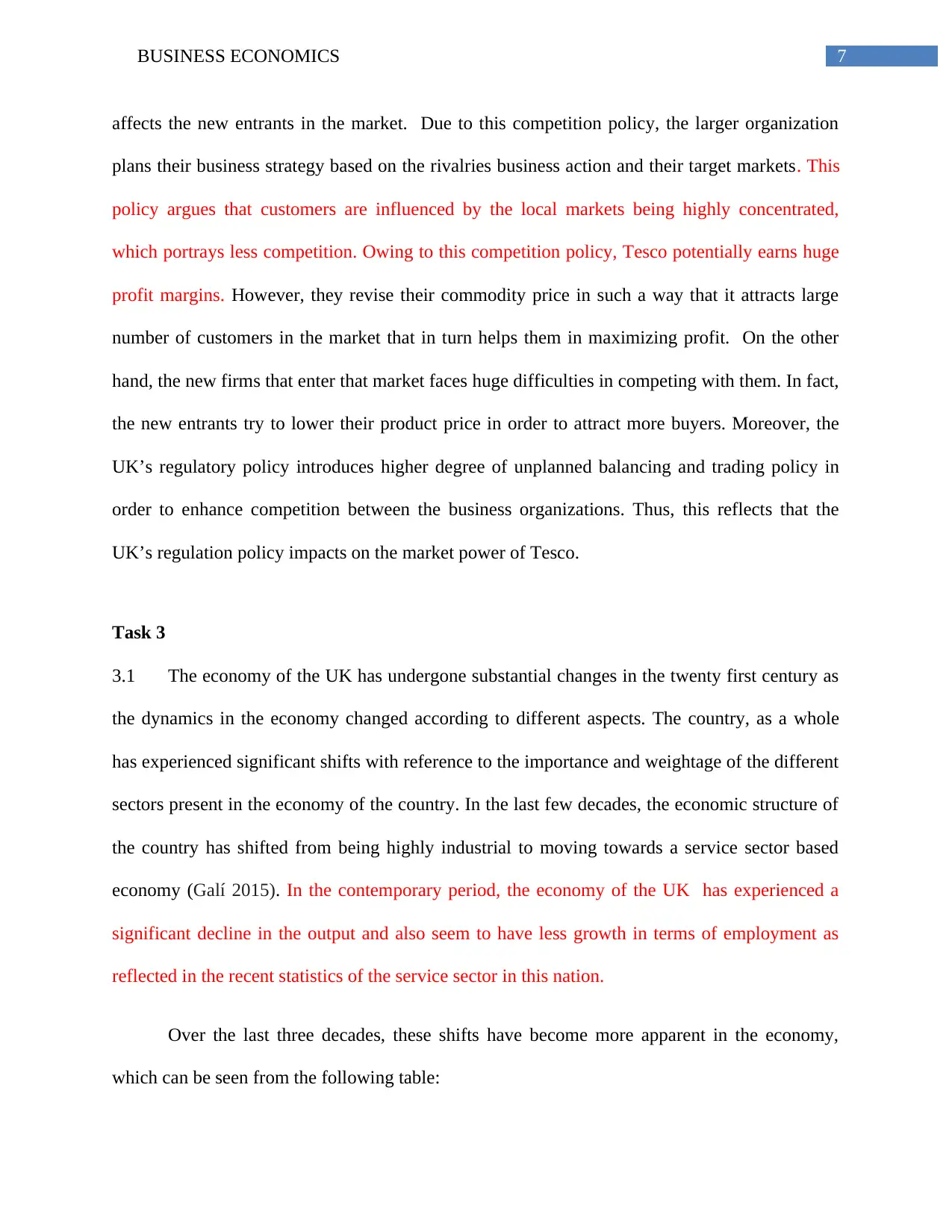
7BUSINESS ECONOMICS
affects the new entrants in the market. Due to this competition policy, the larger organization
plans their business strategy based on the rivalries business action and their target markets. This
policy argues that customers are influenced by the local markets being highly concentrated,
which portrays less competition. Owing to this competition policy, Tesco potentially earns huge
profit margins. However, they revise their commodity price in such a way that it attracts large
number of customers in the market that in turn helps them in maximizing profit. On the other
hand, the new firms that enter that market faces huge difficulties in competing with them. In fact,
the new entrants try to lower their product price in order to attract more buyers. Moreover, the
UK’s regulatory policy introduces higher degree of unplanned balancing and trading policy in
order to enhance competition between the business organizations. Thus, this reflects that the
UK’s regulation policy impacts on the market power of Tesco.
Task 3
3.1 The economy of the UK has undergone substantial changes in the twenty first century as
the dynamics in the economy changed according to different aspects. The country, as a whole
has experienced significant shifts with reference to the importance and weightage of the different
sectors present in the economy of the country. In the last few decades, the economic structure of
the country has shifted from being highly industrial to moving towards a service sector based
economy (Galí 2015). In the contemporary period, the economy of the UK has experienced a
significant decline in the output and also seem to have less growth in terms of employment as
reflected in the recent statistics of the service sector in this nation.
Over the last three decades, these shifts have become more apparent in the economy,
which can be seen from the following table:
affects the new entrants in the market. Due to this competition policy, the larger organization
plans their business strategy based on the rivalries business action and their target markets. This
policy argues that customers are influenced by the local markets being highly concentrated,
which portrays less competition. Owing to this competition policy, Tesco potentially earns huge
profit margins. However, they revise their commodity price in such a way that it attracts large
number of customers in the market that in turn helps them in maximizing profit. On the other
hand, the new firms that enter that market faces huge difficulties in competing with them. In fact,
the new entrants try to lower their product price in order to attract more buyers. Moreover, the
UK’s regulatory policy introduces higher degree of unplanned balancing and trading policy in
order to enhance competition between the business organizations. Thus, this reflects that the
UK’s regulation policy impacts on the market power of Tesco.
Task 3
3.1 The economy of the UK has undergone substantial changes in the twenty first century as
the dynamics in the economy changed according to different aspects. The country, as a whole
has experienced significant shifts with reference to the importance and weightage of the different
sectors present in the economy of the country. In the last few decades, the economic structure of
the country has shifted from being highly industrial to moving towards a service sector based
economy (Galí 2015). In the contemporary period, the economy of the UK has experienced a
significant decline in the output and also seem to have less growth in terms of employment as
reflected in the recent statistics of the service sector in this nation.
Over the last three decades, these shifts have become more apparent in the economy,
which can be seen from the following table:
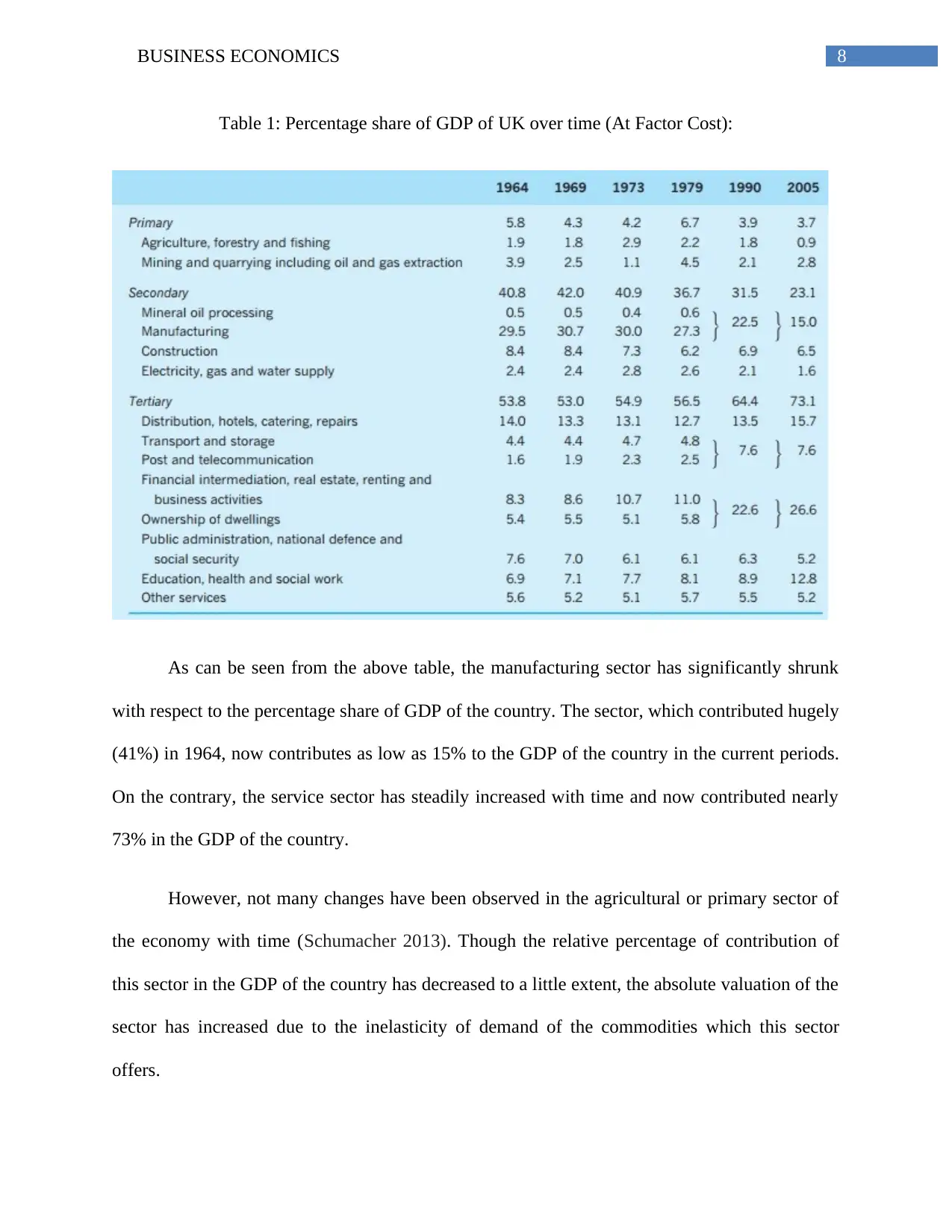
8BUSINESS ECONOMICS
Table 1: Percentage share of GDP of UK over time (At Factor Cost):
As can be seen from the above table, the manufacturing sector has significantly shrunk
with respect to the percentage share of GDP of the country. The sector, which contributed hugely
(41%) in 1964, now contributes as low as 15% to the GDP of the country in the current periods.
On the contrary, the service sector has steadily increased with time and now contributed nearly
73% in the GDP of the country.
However, not many changes have been observed in the agricultural or primary sector of
the economy with time (Schumacher 2013). Though the relative percentage of contribution of
this sector in the GDP of the country has decreased to a little extent, the absolute valuation of the
sector has increased due to the inelasticity of demand of the commodities which this sector
offers.
Table 1: Percentage share of GDP of UK over time (At Factor Cost):
As can be seen from the above table, the manufacturing sector has significantly shrunk
with respect to the percentage share of GDP of the country. The sector, which contributed hugely
(41%) in 1964, now contributes as low as 15% to the GDP of the country in the current periods.
On the contrary, the service sector has steadily increased with time and now contributed nearly
73% in the GDP of the country.
However, not many changes have been observed in the agricultural or primary sector of
the economy with time (Schumacher 2013). Though the relative percentage of contribution of
this sector in the GDP of the country has decreased to a little extent, the absolute valuation of the
sector has increased due to the inelasticity of demand of the commodities which this sector
offers.
⊘ This is a preview!⊘
Do you want full access?
Subscribe today to unlock all pages.

Trusted by 1+ million students worldwide
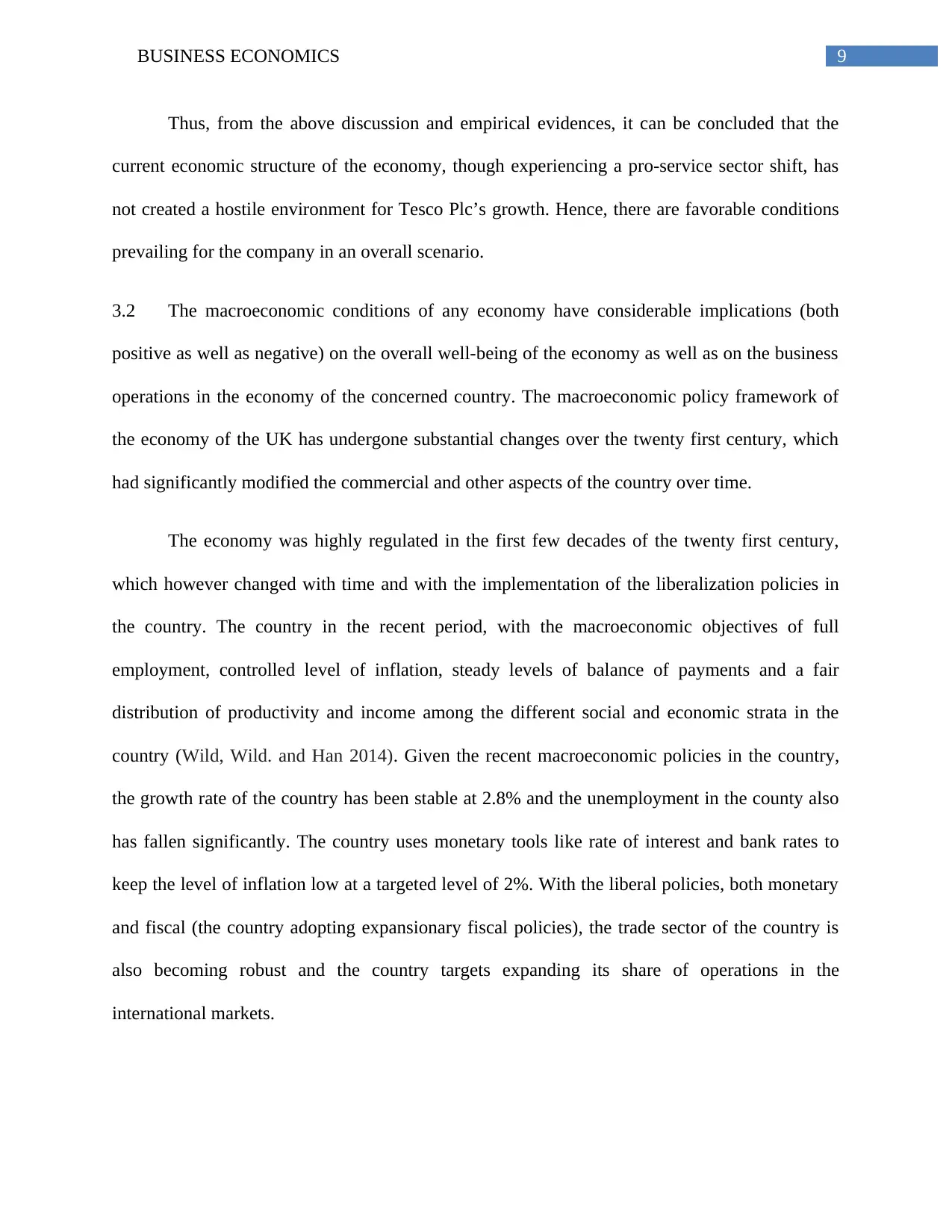
9BUSINESS ECONOMICS
Thus, from the above discussion and empirical evidences, it can be concluded that the
current economic structure of the economy, though experiencing a pro-service sector shift, has
not created a hostile environment for Tesco Plc’s growth. Hence, there are favorable conditions
prevailing for the company in an overall scenario.
3.2 The macroeconomic conditions of any economy have considerable implications (both
positive as well as negative) on the overall well-being of the economy as well as on the business
operations in the economy of the concerned country. The macroeconomic policy framework of
the economy of the UK has undergone substantial changes over the twenty first century, which
had significantly modified the commercial and other aspects of the country over time.
The economy was highly regulated in the first few decades of the twenty first century,
which however changed with time and with the implementation of the liberalization policies in
the country. The country in the recent period, with the macroeconomic objectives of full
employment, controlled level of inflation, steady levels of balance of payments and a fair
distribution of productivity and income among the different social and economic strata in the
country (Wild, Wild. and Han 2014). Given the recent macroeconomic policies in the country,
the growth rate of the country has been stable at 2.8% and the unemployment in the county also
has fallen significantly. The country uses monetary tools like rate of interest and bank rates to
keep the level of inflation low at a targeted level of 2%. With the liberal policies, both monetary
and fiscal (the country adopting expansionary fiscal policies), the trade sector of the country is
also becoming robust and the country targets expanding its share of operations in the
international markets.
Thus, from the above discussion and empirical evidences, it can be concluded that the
current economic structure of the economy, though experiencing a pro-service sector shift, has
not created a hostile environment for Tesco Plc’s growth. Hence, there are favorable conditions
prevailing for the company in an overall scenario.
3.2 The macroeconomic conditions of any economy have considerable implications (both
positive as well as negative) on the overall well-being of the economy as well as on the business
operations in the economy of the concerned country. The macroeconomic policy framework of
the economy of the UK has undergone substantial changes over the twenty first century, which
had significantly modified the commercial and other aspects of the country over time.
The economy was highly regulated in the first few decades of the twenty first century,
which however changed with time and with the implementation of the liberalization policies in
the country. The country in the recent period, with the macroeconomic objectives of full
employment, controlled level of inflation, steady levels of balance of payments and a fair
distribution of productivity and income among the different social and economic strata in the
country (Wild, Wild. and Han 2014). Given the recent macroeconomic policies in the country,
the growth rate of the country has been stable at 2.8% and the unemployment in the county also
has fallen significantly. The country uses monetary tools like rate of interest and bank rates to
keep the level of inflation low at a targeted level of 2%. With the liberal policies, both monetary
and fiscal (the country adopting expansionary fiscal policies), the trade sector of the country is
also becoming robust and the country targets expanding its share of operations in the
international markets.
Paraphrase This Document
Need a fresh take? Get an instant paraphrase of this document with our AI Paraphraser
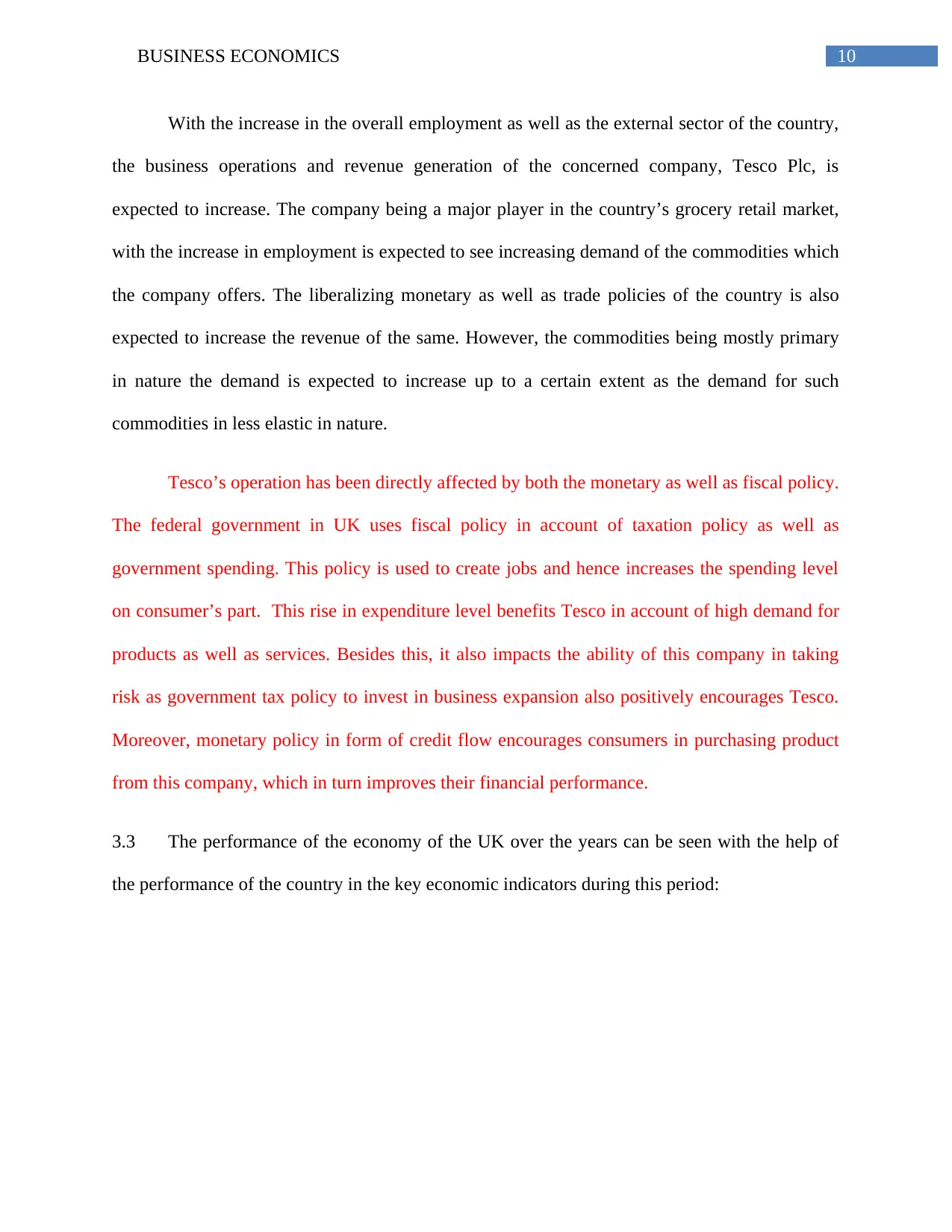
10BUSINESS ECONOMICS
With the increase in the overall employment as well as the external sector of the country,
the business operations and revenue generation of the concerned company, Tesco Plc, is
expected to increase. The company being a major player in the country’s grocery retail market,
with the increase in employment is expected to see increasing demand of the commodities which
the company offers. The liberalizing monetary as well as trade policies of the country is also
expected to increase the revenue of the same. However, the commodities being mostly primary
in nature the demand is expected to increase up to a certain extent as the demand for such
commodities in less elastic in nature.
Tesco’s operation has been directly affected by both the monetary as well as fiscal policy.
The federal government in UK uses fiscal policy in account of taxation policy as well as
government spending. This policy is used to create jobs and hence increases the spending level
on consumer’s part. This rise in expenditure level benefits Tesco in account of high demand for
products as well as services. Besides this, it also impacts the ability of this company in taking
risk as government tax policy to invest in business expansion also positively encourages Tesco.
Moreover, monetary policy in form of credit flow encourages consumers in purchasing product
from this company, which in turn improves their financial performance.
3.3 The performance of the economy of the UK over the years can be seen with the help of
the performance of the country in the key economic indicators during this period:
With the increase in the overall employment as well as the external sector of the country,
the business operations and revenue generation of the concerned company, Tesco Plc, is
expected to increase. The company being a major player in the country’s grocery retail market,
with the increase in employment is expected to see increasing demand of the commodities which
the company offers. The liberalizing monetary as well as trade policies of the country is also
expected to increase the revenue of the same. However, the commodities being mostly primary
in nature the demand is expected to increase up to a certain extent as the demand for such
commodities in less elastic in nature.
Tesco’s operation has been directly affected by both the monetary as well as fiscal policy.
The federal government in UK uses fiscal policy in account of taxation policy as well as
government spending. This policy is used to create jobs and hence increases the spending level
on consumer’s part. This rise in expenditure level benefits Tesco in account of high demand for
products as well as services. Besides this, it also impacts the ability of this company in taking
risk as government tax policy to invest in business expansion also positively encourages Tesco.
Moreover, monetary policy in form of credit flow encourages consumers in purchasing product
from this company, which in turn improves their financial performance.
3.3 The performance of the economy of the UK over the years can be seen with the help of
the performance of the country in the key economic indicators during this period:
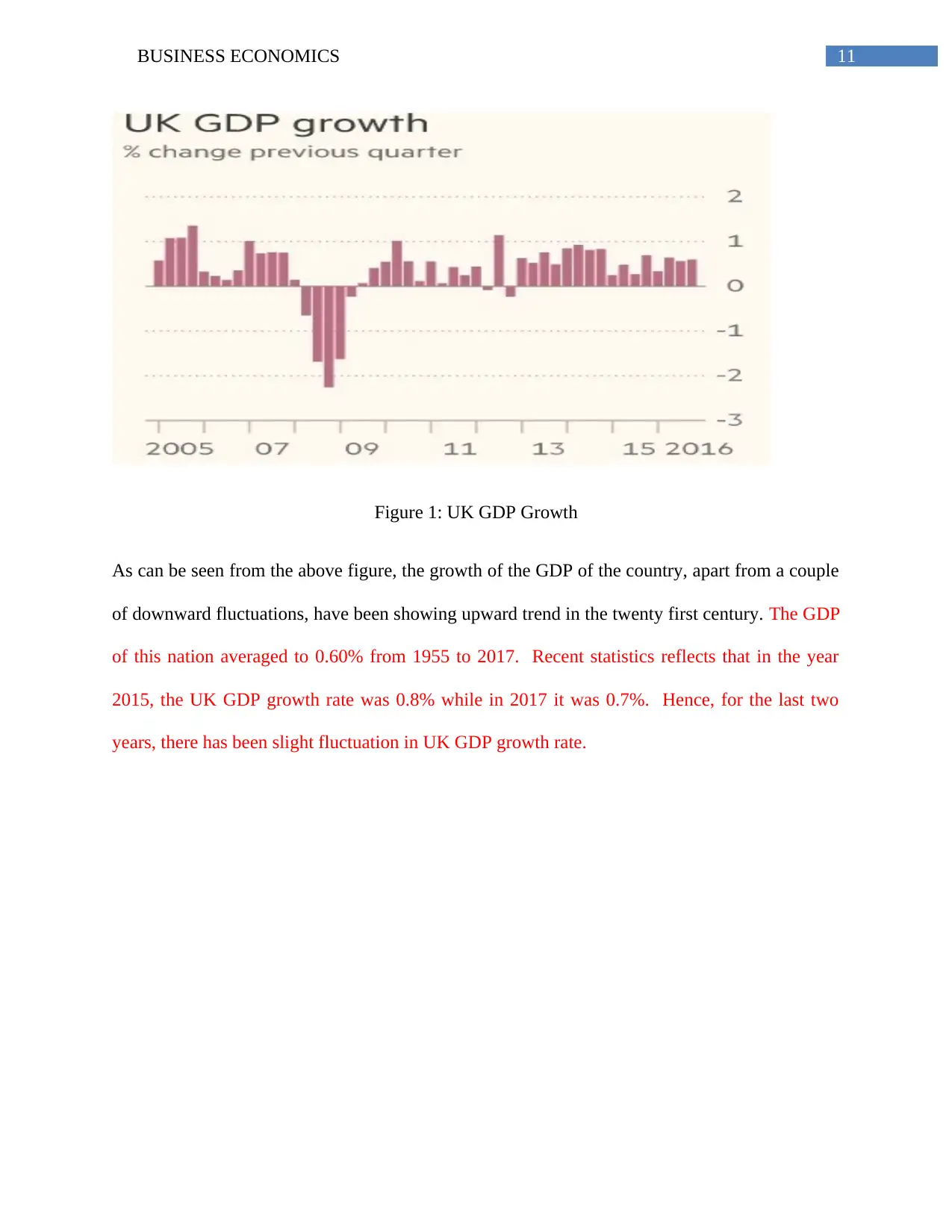
11BUSINESS ECONOMICS
Figure 1: UK GDP Growth
As can be seen from the above figure, the growth of the GDP of the country, apart from a couple
of downward fluctuations, have been showing upward trend in the twenty first century. The GDP
of this nation averaged to 0.60% from 1955 to 2017. Recent statistics reflects that in the year
2015, the UK GDP growth rate was 0.8% while in 2017 it was 0.7%. Hence, for the last two
years, there has been slight fluctuation in UK GDP growth rate.
Figure 1: UK GDP Growth
As can be seen from the above figure, the growth of the GDP of the country, apart from a couple
of downward fluctuations, have been showing upward trend in the twenty first century. The GDP
of this nation averaged to 0.60% from 1955 to 2017. Recent statistics reflects that in the year
2015, the UK GDP growth rate was 0.8% while in 2017 it was 0.7%. Hence, for the last two
years, there has been slight fluctuation in UK GDP growth rate.
⊘ This is a preview!⊘
Do you want full access?
Subscribe today to unlock all pages.

Trusted by 1+ million students worldwide
1 out of 22
Related Documents
Your All-in-One AI-Powered Toolkit for Academic Success.
+13062052269
info@desklib.com
Available 24*7 on WhatsApp / Email
![[object Object]](/_next/static/media/star-bottom.7253800d.svg)
Unlock your academic potential
Copyright © 2020–2025 A2Z Services. All Rights Reserved. Developed and managed by ZUCOL.





